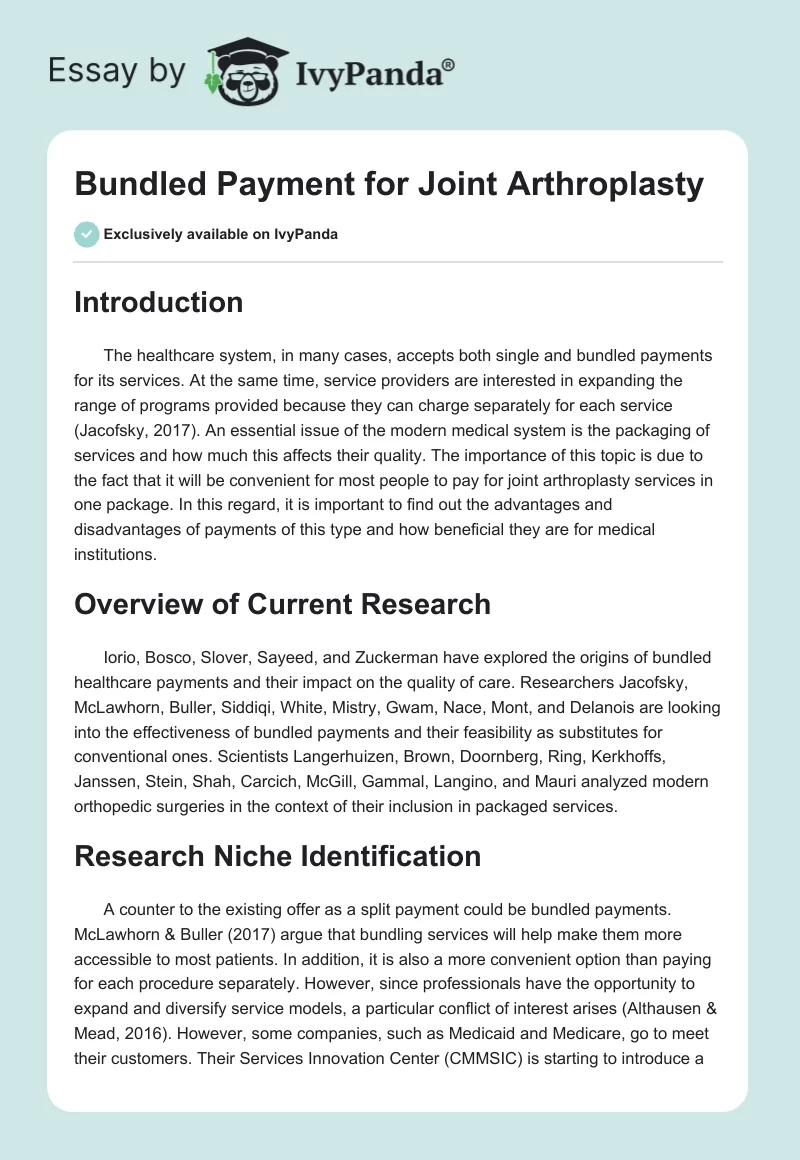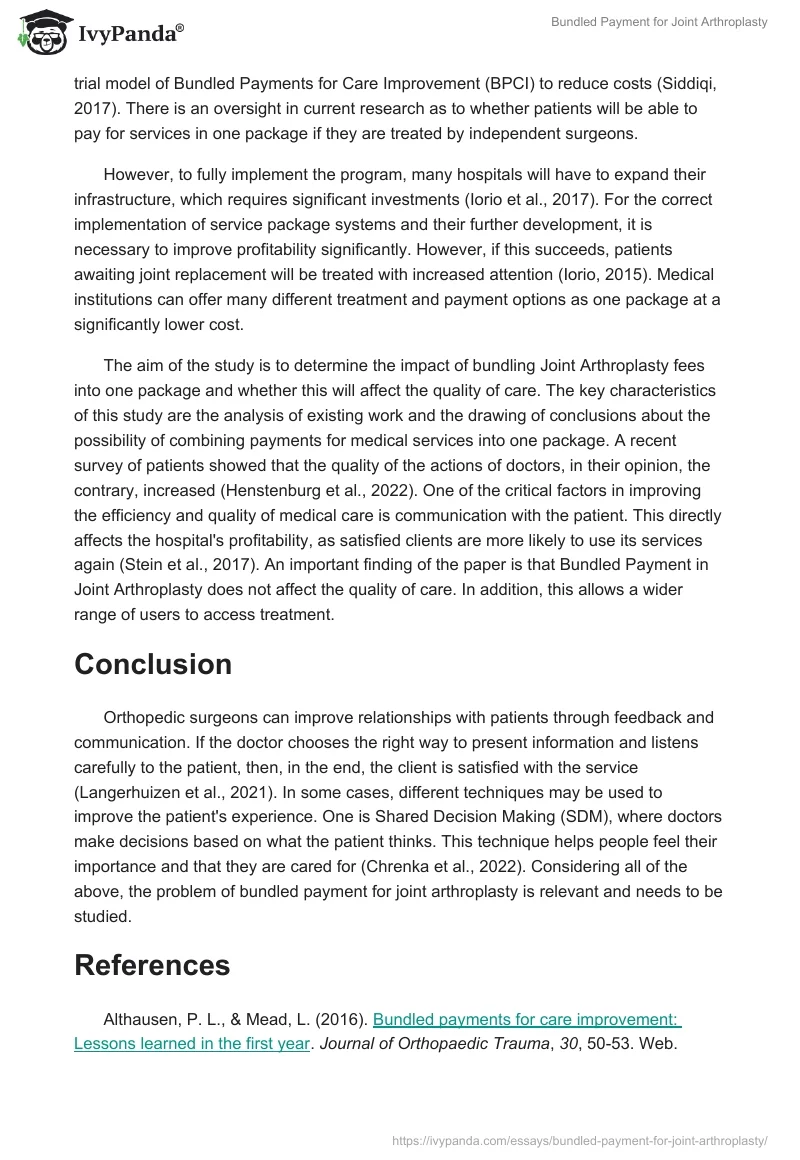Introduction
The healthcare system, in many cases, accepts both single and bundled payments for its services. At the same time, service providers are interested in expanding the range of programs provided because they can charge separately for each service (Jacofsky, 2017). An essential issue of the modern medical system is the packaging of services and how much this affects their quality. The importance of this topic is due to the fact that it will be convenient for most people to pay for joint arthroplasty services in one package. In this regard, it is important to find out the advantages and disadvantages of payments of this type and how beneficial they are for medical institutions.
Overview of Current Research
Iorio, Bosco, Slover, Sayeed, and Zuckerman have explored the origins of bundled healthcare payments and their impact on the quality of care. Researchers Jacofsky, McLawhorn, Buller, Siddiqi, White, Mistry, Gwam, Nace, Mont, and Delanois are looking into the effectiveness of bundled payments and their feasibility as substitutes for conventional ones. Scientists Langerhuizen, Brown, Doornberg, Ring, Kerkhoffs, Janssen, Stein, Shah, Carcich, McGill, Gammal, Langino, and Mauri analyzed modern orthopedic surgeries in the context of their inclusion in packaged services.
Research Niche Identification
A counter to the existing offer as a split payment could be bundled payments. McLawhorn & Buller (2017) argue that bundling services will help make them more accessible to most patients. In addition, it is also a more convenient option than paying for each procedure separately. However, since professionals have the opportunity to expand and diversify service models, a particular conflict of interest arises (Althausen & Mead, 2016). However, some companies, such as Medicaid and Medicare, go to meet their customers. Their Services Innovation Center (CMMSIC) is starting to introduce a trial model of Bundled Payments for Care Improvement (BPCI) to reduce costs (Siddiqi, 2017). There is an oversight in current research as to whether patients will be able to pay for services in one package if they are treated by independent surgeons.
However, to fully implement the program, many hospitals will have to expand their infrastructure, which requires significant investments (Iorio et al., 2017). For the correct implementation of service package systems and their further development, it is necessary to improve profitability significantly. However, if this succeeds, patients awaiting joint replacement will be treated with increased attention (Iorio, 2015). Medical institutions can offer many different treatment and payment options as one package at a significantly lower cost.
The aim of the study is to determine the impact of bundling Joint Arthroplasty fees into one package and whether this will affect the quality of care. The key characteristics of this study are the analysis of existing work and the drawing of conclusions about the possibility of combining payments for medical services into one package. A recent survey of patients showed that the quality of the actions of doctors, in their opinion, the contrary, increased (Henstenburg et al., 2022). One of the critical factors in improving the efficiency and quality of medical care is communication with the patient. This directly affects the hospital’s profitability, as satisfied clients are more likely to use its services again (Stein et al., 2017). An important finding of the paper is that Bundled Payment in Joint Arthroplasty does not affect the quality of care. In addition, this allows a wider range of users to access treatment.
Conclusion
Orthopedic surgeons can improve relationships with patients through feedback and communication. If the doctor chooses the right way to present information and listens carefully to the patient, then, in the end, the client is satisfied with the service (Langerhuizen et al., 2021). In some cases, different techniques may be used to improve the patient’s experience. One is Shared Decision Making (SDM), where doctors make decisions based on what the patient thinks. This technique helps people feel their importance and that they are cared for (Chrenka et al., 2022). Considering all of the above, the problem of bundled payment for joint arthroplasty is relevant and needs to be studied.
References
Althausen, P. L., & Mead, L. (2016). Bundled payments for care improvement: Lessons learned in the first year. Journal of Orthopaedic Trauma, 30, 50-53. Web.
Chrenka, E. A., Solberg, L. I., Asche, S. E., Dehmer, S. P., Ziegenfuss, J. Y., Whitebird, R. R., Norton, C. K., Reams, M., Johnson, P. G., & Elwyn, G. (2022). Is Shared Decision-making Associated with Better Patient-reported Outcomes? A Longitudinal Study of Patients Undergoing Total Joint Arthroplasty. Clinical Orthopaedics & Related Research®, 480(1), 82–91. Web.
Henstenburg, J., Shah, S. A., Carrion, R., & Josephson, G. (2022). The Role of Satisfaction Surveys: Offering an Enhanced Patient Experience for Optimum Outcomes in the Pediatric Orthopaedic Practice. Journal of Pediatric Orthopaedics, 42, S13–S17. Web.
Iorio, R. (2015). Strategies and tactics for successful implementation of bundled payments: Bundled payment for care improvement at a large, urban, academic medical center. The Journal of Arthroplasty, 30(3), 349-350. Web.
Iorio, R., Bosco, J., Slover, J., Sayeed, Y., & Zuckerman, J. D. (2017). Single institution early experience with the bundled payments for care improvement initiative. JBJS, 99(1), e2. Web.
Jacofsky, D. J. (2017). Episodic payments (bundling) PART I. The Bone & Joint Journal, 99(10), 1280-1285. Web.
Langerhuizen, D. W. G., Brown, L. E., Doornberg, J. N., Ring, D., Kerkhoffs, G. M. M. J., & Janssen, S. J. (2021). Analysis of Online Reviews of Orthopaedic Surgeons and Orthopaedic Practices Using Natural Language Processing. Journal of the American Academy of Orthopaedic Surgeons, 29(8), 337–344. Web.
McLawhorn, A. S., & Buller, L. T. (2017). Bundled payments in total joint replacement: Keeping our care affordable and high in quality. Current Reviews in Musculoskeletal Medicine, 10(3), 370-377. Web.
Siddiqi, A., White, P. B., Mistry, J. B., Gwam, C. U., Nace, J., Mont, M. A., & Delanois, R. E. (2017). Effect of bundled payments and health care reform as alternative payment models in total joint arthroplasty: A clinical review. The Journal of Arthroplasty, 32(8), 2590-2597. Web.
Stein, S. M., Shah, S. S., Carcich, A., McGill, M., Gammal, I., Langino, M., & Mauri, T. (2017). A Novel Approach to Improving Patient Experience in Orthopedics. American Journal of Medical Quality, 32(6), 655–660. Web.


